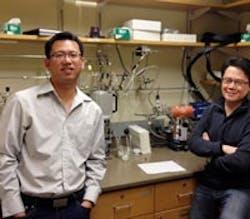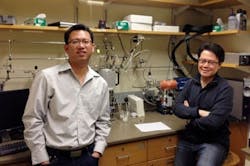Porous Nanostructure Boosts Selectivity
Teaming a thin porous skin with a tiny chamber between that skin and a catalyst core promises better catalyst selectivity , say researchers at Boston College, Chestnut Hill, Mass. The so-called yolk-shell configuration outperforms catalysts with a sieving layer directly on top of the core, they add.
CATALYST COLLABORATORS
Figure 1. Chia-Kuang "Frank" Tsung (right) and postdoc Dr. Chun-Hong Kuo (left) stand in front of microreactor. Source: Frank Tsung. A polycrystalline metal-organic frameworks (MOF) forms the porous shell. "We can make these pores very precisely… We can change their composition and chemical properties in order to accept or reject certain types of reactions," notes Chia-Kuang "Frank" Tsung, an assistant professor of chemistry, who led the research.The cavity between the catalyst core and the shell makes greater core surface area available than for catalysts with a sieving layer directly on the core — leading to more homogeneous interactions, note the researchers. The team applied a shell of ZIF-8 — a highly refined metal-organic framework (MOF) — to a nanoscale metallic crystal covered with a layer of copper oxide. The MOF adhered immediately to the copper oxide and began to pick away at the material, creating a skin with pore-like pockets that limit what molecules can reach the crystal to form chemical reactions.Gases of varying molecular size were used to test the structure. Smaller size molecules could pass through the pores and reach the catalyst, while larger molecules were blocked. The yolk-shell catalysts can be tailored for specific reactions. "This is definitely the most attractive part of our design," says Tsung. "The vast and growing array of MOF materials combined with their modifiability allows us to custom tune the shell for the reaction at hand. We can modify the pore structures of the shell to generate size, regio-, stereo-, and enantio-selectivity. Additionally, we can manipulate the chemical composition of the shell to affect its sorption behavior in order to enrich the local concentration of a desired molecule. We can even tune the pore sizes to control the product distribution in a polymerization reaction."More details can be found in a recent article in the Journal of the American Chemical Society."Chemical processes with multiple catalytic steps could be made vastly more efficient and cost effective if two or more steps were integrated with one advanced catalyst. The large cavity in our design allows the incorporation of multiple catalyst cores, enabling tandem catalysis between them," adds Tsung.Work is underway to try other cores, shells and new reactions; the team expects that finding the best combination will take another one to two years. "…The preliminary results encourage us to extend this concept to many different reactions…The ultimate goal is to use the 'skin' to promote the performances of many existing catalysts. Initial targets will be solar to chemical energy conversion reactions," notes Tsung.Other catalytic cores amenable to the approach include platinum-group-metal nanoparticles, non-precious-metal nanoparticles, metal oxide nanoparticles, semiconductor nanocrystals, and homogeneous organo-metallic catalysts.Thermal stability currently is a major challenge that needs to be addressed. However, it's not the cavity that poses limitations, Tsung says, but the use of MOFs as the shell. "MOF shells are easy to synthesize, modify and manipulate, but their thermal stability is relatively low. Now that we have demonstrated the advantages of having a nanoporous shell on the surface of active catalysts, we are currently working to expand this concept to high-temperature reactions by using inorganic zeolites as the shells, which are also ordered nanoporous materials, but much more robust. The syntheses of these materials are much more challenging, but our preliminary success with MOFs makes it worth trying," he explains.In preparation for scale-up, Tsung's team works with commercially available industrial-scale reagents and expects with the current rate of progress that pilot scale testing could begin within a year.Tsung says his team is more than happy to collaborate with any engineers or scientists to design a catalyst for a specific reaction.
